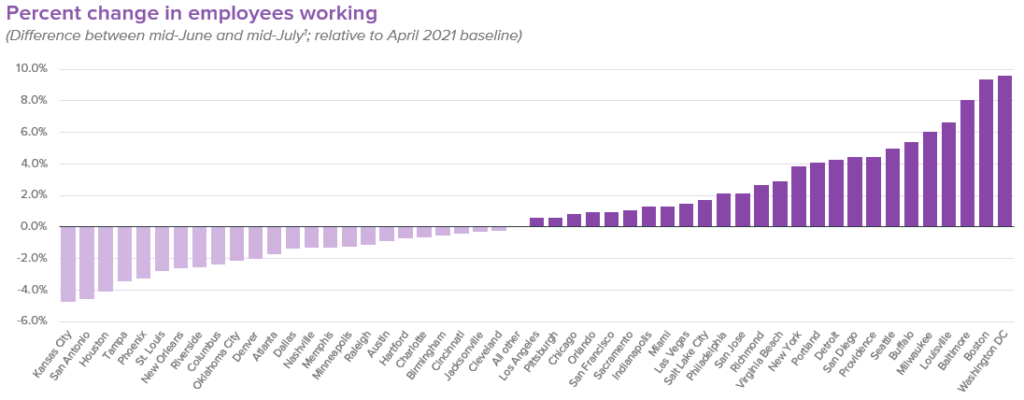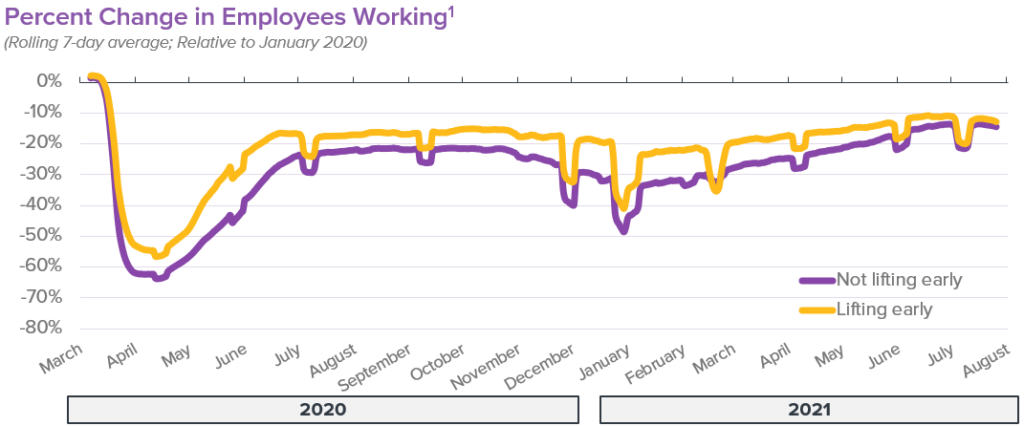Every month, we share our thoughts on the state of Main Street amid the global pandemic. With information from over 60,000 businesses and one million active hourly employees, our data offers insight into how the US small business economy is faring and what we might expect in the coming months ahead.
You can find the full report here, but here’s a snapshot of what we saw in July.
How did Main Street fare in July (30-second snapshot)?
In July, the number of employees working declined for the first time in 2021. While this decline was minimal (0.4%), the end of the month trajectory indicates that this trend may continue in August.
Current national hiring challenges likely play a role in the slight employment decline, but state differences have a large impact. Specifically, states that voted Republican saw slower to negative growth in July compared to states that voted Democrat.
This is likely due to the fact that Republican states maintained higher employment throughout the COVID-19 pandemic and thus had less room to recover.
Flat to declining in July
While we have seen growth through Q2, July showed the first month-over-month decline in 2021.

State and MSA perspectives
As we dive deeper into the data, it is clear that there are significant differences between regions. 18 states and 3 regions saw declining employment, while half saw increasing employment. The regions most negatively affected were the Plains, Southwest, and Southeast. Additionally, nearly half of major MSAs also saw declines.


Comparing Republican and Democratic states
One potential explanation for these differences is a different approach to government restrictions that altered the employment growth path. When we compared states that voted Republican to states that voted Democrat in the 2020 US presidential election, there is a clear difference.
States that voted Republican maintained higher employment throughout the pandemic. States that voted Democrat have grown more quickly in 2021 and have now reached an equal level with Republican states.

This trend is consistent when comparing states that lifted additional federal unemployment benefits early against those that maintained those additional benefits.


Hospitality and entertainment industries continue to gain
Despite declines in states and MSAs, some industries continued to grow. Entertainment and hospitality continued to significantly outpace other industries, growing 8% and 12% respectively last month. Food, Drink & Dining, Beauty & Wellness, and Public or Nonprofit also saw growth.
Impressively, businesses in both the entertainment and hospitality industries have surpassed their pre-COVID employment levels by ~10-15%.


How has Homebase data been validated?
We’ve partnered with a number of academics, researchers, and policymakers to validate and improve our data. Here are a few examples:
- The St. Louis Federal Reserve suggested that Homebase data could be predictive of the jobs reports
- Researchers at Yale used Homebase data to determine the impact of expanded UI benefits on employment
- A team at UChicago and Berkeley used Homebase data to show disparate impacts across different groups
Methodology and definitions
The January 2020 dataset is based on Homebase data gathered from over 60,000 businesses and 1 million hourly employees active in the US in January 2020. All the rates compare that day vs. the average for that day of the week for the period Jan 4, 2020 – Jan 31, 2020. The April 2021 dataset does the same, except it looks at the period April 3, 2021 – April 30, 2021.
- “Hours worked” is calculated from hours recorded in Homebase timecards
- “Locations open” is based on whether a business had at least one employee clock-in
- “Employees working” is based on the distinct number of hourly workers with at least one clock-in
Questions or comments about our findings?
Contact Ray Sandza (VP, Data & Analytics) or Adam Beasley (Manager, Data Products) to learn more about our findings and our data.
Homebase makes work easier for 100,000+ small (but mighty) businesses with everything they need to manage an hourly team: employee scheduling, time clocks, team communication, hiring, onboarding, and compliance. We are not Human Capital Management. We are not HR Software. We’re tools built for the busiest businesses, so owners and employees can spend less time on paperwork and more time on what matters.

